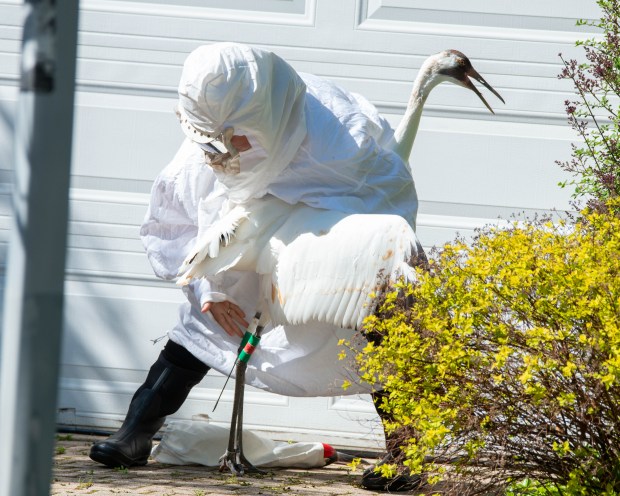When experts with the International Crane Foundation in Wisconsin heard that a whooping crane needed rescuing in Wilmette, they loaded their crane costume and a bunch of grapes into a car and sped to the north suburb.
When they got to the 500 block of Meadow Drive in Wilmette on April 23, the crane was still there, so they put into action their tried and true method for crane rescues: They broke out the crane costume and a handful of green grapes.
“We’ve had birds that go off track,” said Anne Lacy, director of eastern flyway programs North America with the International Crane Foundation (ICF) in Baraboo, Wisconsin.
“Sometimes they find themselves in a dangerous place,” she added. “When we had word of a bird in a suburban Chicago front yard…she was obviously lost.”
“She cannot find appropriate food,” Lacy explained. “There’s no water nearby. Cranes cannot nest in trees because they don’t have a hind toe to grab on. They require water for safe roosting overnight. They stand in water. That’s their safety. Without that she’d be in extra danger. There’s traffic. Dogs. Power lines. The risks to her were pretty great.”
Lacy said colored bands on the crane’s legs allowed the ICF to identify it as “Animal,” a bird that had been born in captivity in Wisconsin about a year ago and named after a Muppets character. She said the bird is officially known as 16-23, meaning she was the 16th egg that hatched at ICF in 2023. The bird weighs between eight and nine pounds and is about 5 feet tall.
“A lost bird doesn’t necessarily require intervention,” Lacy said. “But in this case she was a young bird. She was naive and wasn’t really in appropriate habitat.”
In order to rescue “Animal” and not scare her away, one of the ICF members slipped into the organization’s crane costume and carefully made her way toward the bird.
“It’s not so much to look like a crane as it is to hide the human form,” Lacy said of the white, bulky costume. She said the costume has a helmet and visor so the bird can’t see any human face, wings with black tips, black boots and, on one arm, there’s a realistic-looking whooping crane puppet head.
“That’s what our ‘captive staff’ use to actually provision chicks when they’re very young in captivity to teach them how to find natural foods,” she explained. “They come out of the egg seeing that. They know it’s not people so they don’t associate it with people and they don’t imprint on that. They do know that (it’s) a big white bird with that black moustache and red head; that’s what they imprint on.”
The woman in the costume was able to get close enough to Animal to offer her one of her favorite treats, a green grape, and the bird was bundled up, taken back to Wisconsin and released.
Lacy said volunteers with the Chicago Ornithological Society, a local vet and others were essential in the bird’s successful rescue.
“The birding community is like that,” she said. “They will rally for any bird that is unusual or in trouble or pretty or all of the above.”
Lacy said whooping cranes were put on the endangered species list in 1973 and that in the 1940s and 50s there were only 15 of them in the world, mostly on the Texas coast. There are now about 850 of the birds in the world.
“If you can count all of a ‘thing,’ that’s not very many,” she said. “But that is phenomenal considering they came from 15 to 20 birds not too long ago.”
“Key to this ‘reintroduction’ is letting people know that there are whooping cranes now in the eastern flyway of the United States,” she added. “So people know that they’re around. They knew this crane was young, was lost and shouldn’t be there. That’s what gave us a happy ending.”



